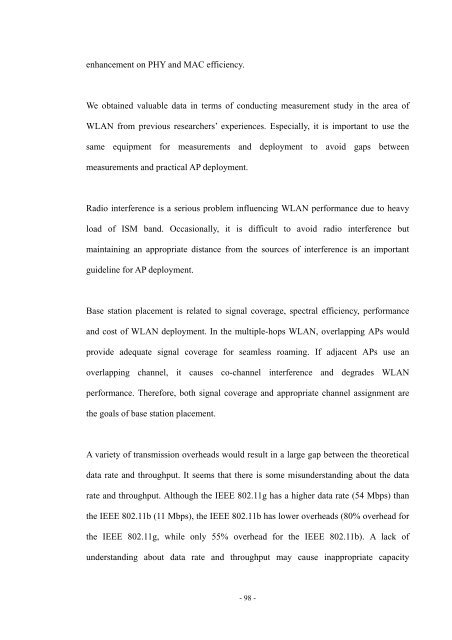An Investigation of the Impact of Signal Strength on Wi-Fi Link ...
An Investigation of the Impact of Signal Strength on Wi-Fi Link ...
An Investigation of the Impact of Signal Strength on Wi-Fi Link ...
Create successful ePaper yourself
Turn your PDF publications into a flip-book with our unique Google optimized e-Paper software.
enhancement <strong>on</strong> PHY and MAC efficiency.<br />
We obtained valuable data in terms <str<strong>on</strong>g>of</str<strong>on</strong>g> c<strong>on</strong>ducting measurement study in <str<strong>on</strong>g>the</str<strong>on</strong>g> area <str<strong>on</strong>g>of</str<strong>on</strong>g><br />
WLAN from previous researchers’ experiences. Especially, it is important to use <str<strong>on</strong>g>the</str<strong>on</strong>g><br />
same equipment for measurements and deployment to avoid gaps between<br />
measurements and practical AP deployment.<br />
Radio interference is a serious problem influencing WLAN performance due to heavy<br />
load <str<strong>on</strong>g>of</str<strong>on</strong>g> ISM band. Occasi<strong>on</strong>ally, it is difficult to avoid radio interference but<br />
maintaining an appropriate distance from <str<strong>on</strong>g>the</str<strong>on</strong>g> sources <str<strong>on</strong>g>of</str<strong>on</strong>g> interference is an important<br />
guideline for AP deployment.<br />
Base stati<strong>on</strong> placement is related to signal coverage, spectral efficiency, performance<br />
and cost <str<strong>on</strong>g>of</str<strong>on</strong>g> WLAN deployment. In <str<strong>on</strong>g>the</str<strong>on</strong>g> multiple-hops WLAN, overlapping APs would<br />
provide adequate signal coverage for seamless roaming. If adjacent APs use an<br />
overlapping channel, it causes co-channel interference and degrades WLAN<br />
performance. Therefore, both signal coverage and appropriate channel assignment are<br />
<str<strong>on</strong>g>the</str<strong>on</strong>g> goals <str<strong>on</strong>g>of</str<strong>on</strong>g> base stati<strong>on</strong> placement.<br />
A variety <str<strong>on</strong>g>of</str<strong>on</strong>g> transmissi<strong>on</strong> overheads would result in a large gap between <str<strong>on</strong>g>the</str<strong>on</strong>g> <str<strong>on</strong>g>the</str<strong>on</strong>g>oretical<br />
data rate and throughput. It seems that <str<strong>on</strong>g>the</str<strong>on</strong>g>re is some misunderstanding about <str<strong>on</strong>g>the</str<strong>on</strong>g> data<br />
rate and throughput. Although <str<strong>on</strong>g>the</str<strong>on</strong>g> IEEE 802.11g has a higher data rate (54 Mbps) than<br />
<str<strong>on</strong>g>the</str<strong>on</strong>g> IEEE 802.11b (11 Mbps), <str<strong>on</strong>g>the</str<strong>on</strong>g> IEEE 802.11b has lower overheads (80% overhead for<br />
<str<strong>on</strong>g>the</str<strong>on</strong>g> IEEE 802.11g, while <strong>on</strong>ly 55% overhead for <str<strong>on</strong>g>the</str<strong>on</strong>g> IEEE 802.11b). A lack <str<strong>on</strong>g>of</str<strong>on</strong>g><br />
understanding about data rate and throughput may cause inappropriate capacity<br />
- 98 -
















